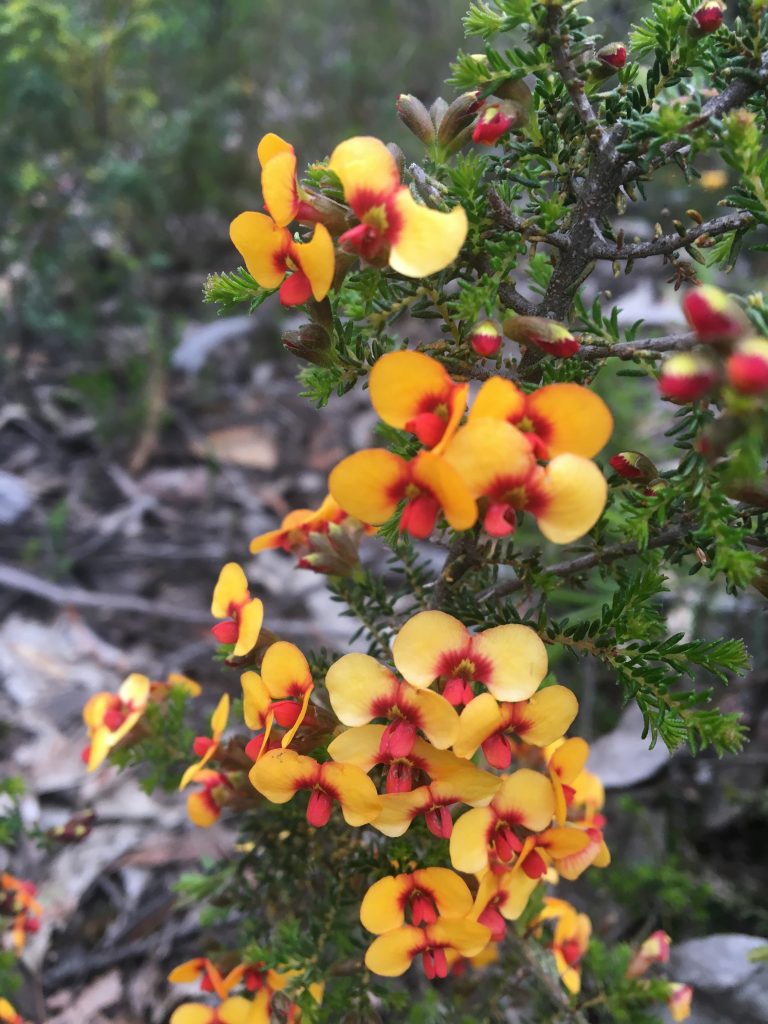In March 2021, I was delighted to bump into Marie Jones, one of the key forces behind Connecting Country – who said “hold on – Bronwyn is on her way.. with the pea book!”. I was very happy to have a chat with Marie and also touch base with Bronwyn Silver, photographer and naturalist – and receive a copy of this lovely publication. I promised a review – and here it is! Better late than never eh? 🙂
Like the enormously popular moss, acacia and eucalypt guides that have been published previously by Friends of the Box-Ironbark Forests Native Peas of the Mount Alexander region is pocket-sized and very attractive! But I think this volume is my favourite so far! Whether that is because I am very much a fan of the native peas or “egg and bacon” plants, or because this book is the best of the series I cannot say : )
I have written about the Wombat Forest region peas a few times on this blog, in my book and in the local paper – and while this book is focused on peas of the Mount Alexander (Castlemaine) region and specifically Box Ironbark forest it is still an excellent addition to any plant enthusiasts’ natural history bookshelf.
The text is succinct but very engaging, with a warm nod to the work of the late and much-loved Ern Perkins and his substantial contribution to the study of the local flora.
While I am familiar with my local pea species, I have never bothered to learn the names of the plant parts – particularly the flower structure. The distinctive upright back petal of a pea flower is called the standard – and may vary from genus to genus. Dillwynnia phyllicoides show “a clearly divided standard like Micky Mouse ears” , while in Pultenea graveolens “the standard tends to sit like a monk’s cowl”. Lovely imagery! Bernard Slattery wrote most of the text, while Bronwyn supplied all of the beautiful photos, unless the photographer is credited…

Dillwynnia phyllicoides with “Mickey Mouse ears” – there are about five of these lovely little shrubs on my street in Porcupine Ridge.
There is a very helpful section on identifying your first peas – which lists possible species you may be observing in the Box Ironbark forest according to whether they have a trailing, vine-like habit, or are perhaps a small or large shrub.This part is a nice exercise in getting to know pea characteristics, but not applicable for readers in the Wombat forest, Ballarat and Daylesford region.
BUT I was delighted to see a very handy list of species “native pea species growing on the margins of our region”, which includes the Wombat Forest’s distinctive Leafless Bossiaea, and the wonderful Hop Bitter Pea Davaesia latifolia which I have pictured here – and other wetter forest species.

Daviesia latifolia – Hop Bitter-pea. This one large shrub, again on my street in Porcupine Ridge, has the MOST spectacular floral display each year!
The other thing I found very interesting about this tiny but useful book is an excellent essay at the book’s end titled “Science and Social History: what’s in a name”. I never knew that genera names such as Bossiaea, Daviesia, and Dillwynnia are named after a French naturalist, a Welsh clergyman and a British naturalist. Blah – I thought they were names after Greek goddesses or were literal descriptions as per Platylobium (Greek) platys = flat and lobos = pod. Bernard writes: “it is notable that there are no aboriginal names in the list below, a sign perhaps of the general European belief that Indigenous people had little or no understanding of the environment they lived in”. Ah – such a great tragedy – their knowledge would have been extremely specific and based on literally thousands of years of observation and understanding.
Since encountering Marie and Bronwyn all those months ago – yet another small volume has been produced by the indefatigable team. “Twenty Bushwalks in the Mount Alexander region” is a handy guide to walks that FOBIF members have been enjoying for decades. In covid times what better way to enjoy these wonderful walks than solo or with one other nature friend? Both the pea book and this book – and indeed all of these books can be purchased directly from the FOBIF website here.

0 Comments